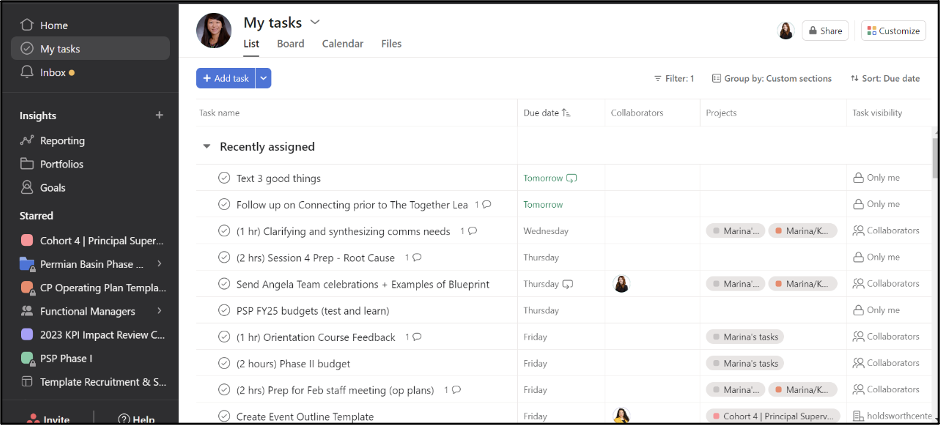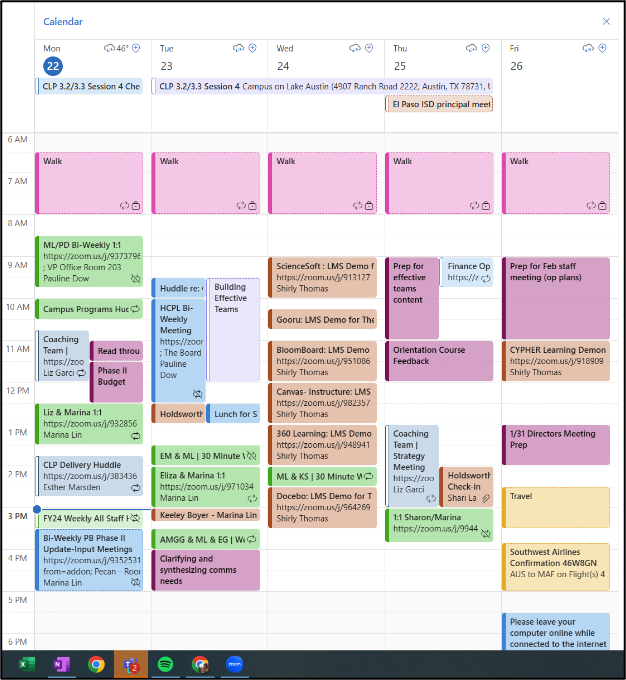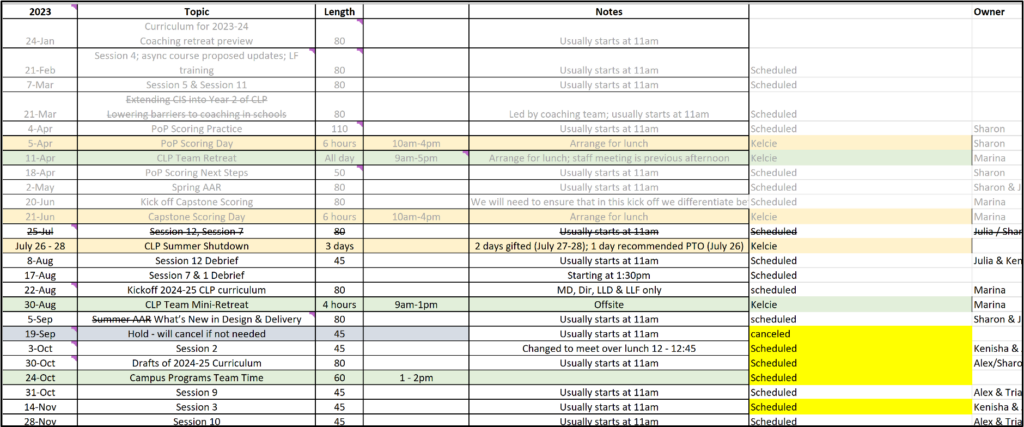Together Friends,
Oooooh, this time of year is a whole thing, right? Hiring, perhaps? Planning for summer onboarding? Handling staff transitions? Carving out space for a Retreat of One? Figuring out your own personal vacation plans? We would love to write about how people are Together-ing their summers, so if you have an artifact, thought, or document, send it directly to me.
And, we are back with another Together Tour – this time on the nonprofit side. And fear not, school-, district-, and CMO-based readers, we ALL learn things from each other’s Together journeys – no matter what our role. Let’s peek at Marina Lin’s Outlook / Asana system!
Want more Together Tours? Nominate yourself or others by clicking here. We are looking for a few more teachers to showcase in the coming months, especially with the school year coming to a close. Fine print: We will not be able to showcase all nominations, but we will read them all in depth and reply!
Together Tour: Marina Lin
Marina and I crossed paths several times over the past few years in her senior leadership role at The Holdsworth Center in Austin, Texas. Immediately, our team was struck by her intentionality, her tech prowess, and her articulation of how Togetherness needs to shift and change as organizations grow and scale.

Why is Togetherness essential in your role?
The type of work we are doing is complex, and it requires a lot of different people with different expertise and skillsets and perspectives to come together. Every minute counts in the time we spend with education leaders; they are busy and we must make the most of their time with us. In our early years, our methods looked more like “let a thousand flowers bloom,” and we all had to do whatever was necessary to efficiently get things off the ground. Now that things are more stable with our collective vision, there are systems and tools we need to share across the organization.
What are your Top Together Tools and why?
The first tool I use is Asana—it is how I organize my time and make sure I am “on track” with projects big and small. My team has a lot of Asana tasks assigned to us by a Program Coordinator – this is possible because the way we prepare for sessions is fairly uniform for each session and we have templates already built out in Asana. I also assign tasks to my three sub-teams (and they assign tasks to me), and we can all check in on each other’s projects.
I have “My Tasks” in Asana pulled up as a tab, every single workday, and I scan it in the mornings and throughout the day to see what is due in the two weeks ahead — and if I’m feeling extra organized, I’ll scan up to 2-3 months out just to see what is coming. This list shows me everything – things I’ve assigned myself that are tiny reminders, things that I’ve assigned myself that are more substantial tasks, and things that others have assigned to me. I spend a little time each week just making sure that I have considered what I need to be doing in the next month or so to make progress towards large, six-month objectives.

Anything that is a large task (i.e. 30 minutes or more) gets tagged with the project “Marina’s Tasks” and I put a time estimate for how much work time I need to set aside.
The second tool I rely upon heavily is my Outlook calendar. My tasks from Asana are reflected in my calendar as work blocks. I color-code them purple so my colleagues can tell they are different from meetings and that they can treat them differently for scheduling purposes.

And the last chunk of Together things we do are organization wide. These are our OKRs (Objectives and Key Results), two-year operating plans, and six-month priorities. All these things help us see we are traveling in the same direction. These tools translate to meetings and individual work assignments.
What is the first and last thing you do at work each day?
To start my day, I do the following:
- Look at my Outlook calendar for that day, as well as the rest of the week, to know what is coming up.
- I also pull up my email and Asana tab to scan for the things that are urgent or really important to get done as quickly as I can, and figure out where they go.
- Depending on the day, I ask myself what are the 3-5 things I must get done? This week is spring break, which means my calendar is more spacious than usual so I’m looking at Asana a month out, and finding anything I can start working on now. I know the next two weeks after this are really heavy. (Editor’s Note: We love this anticipatory mindset. We call this Forecasting Forward!)
At the end of the day, I try to have a hard stop. I like to try and close out by 6 PM, unless I have an evening event. I have had to develop this skill over my career. I used to keep working but, as we all know, work decreases in quality as our brains become more tired.
How do you use Togetherness with colleagues, students, managers, and others?
I lead a team of 13 people. At the start of our time together, our meetings were very ad hoc because we were in startup mode. We always held time every week to come together and talk about the content and curriculum, and everyone would bring ideas.
Over time, and as we grew, we had a lot more predictability in our work, which allowed for a step-back on meeting culture. Now our meetings can be more strategic and predictable, which allows us to plan them out pretty far in advance. We have established a Meeting Matrix to help us anticipate which meetings we need and why, who is the owner of the meeting, and the status of scheduling. (Editor’s Note: Chapter 5 of The Together Leader has a great chapter on and examples of Meeting Matrices.)
In fact, during meetings I can have the spreadsheet pulled up and go ahead and start filling it out, using previous years as an example. This takes a lot of the thinking out of it, which is great! This also helps give the whole team clarity and transparency. For example, everyone knows when we will look at Session 6 survey data and when we will look at how many contractors we need to hire this year, because we have those in an annual cadence. This is key because it helps us lock down the predictable, giving room for stuff that comes up that is not predictable. We’re always asking ourselves: is this a topic for a meeting or could it be an email?

Some Together Tricks I do that no one knows about are. . .
Early in my career, I read Eat that Frog, and have taken the idea to heart. I often will schedule the thing I’m dreading the most first thing. If it is personal thing, it’s the thing I have to do before I can hang out and have fun. I call this my own internal bribery!
When you are at your most Together, your lunch at work is _________!
Something that I cook in bulk on Sundays, that reheats well – such as Japanese curry! (Editor’s Note: Marina’s Japanese curry recipe is listed at the end of the post!)
Marina, thank you for sharing your entire systems with us! Anyone else out here totally digital?
We’ll be back in May with another Together Tour. Who should I feature next time?
Together Treasure Box 
- In need of some calendar hacks? We’ve collected some tech tips and tricks to make your calendar work better for you and your dynamic schedule.
- How colorful is your calendar? Are you Team Color Code? By type of work? By human? By location? Or is greyscale more your vibe?
- Getting back to reality after a vacation can be tough. Many of us have recently come back from Spring Break. It’s a perfect time for a post-break calendar sweep to gear up for the spring and summer!
A Taste of Togetherness: Marina’s Japanese Curry Recipe
Japanese Curry with Chickpeas
(This makes a lot – probably 8-10 servings?)
Ingredients
1 lb dried chickpeas (or equivalent in canned chickpeas)
1 large white or yellow onion, diced
1 lb carrots, peeled and diced
4 medium potatoes, peeled and diced
7oz package of Japanese curry mix (I like S&B Tasty Curry or Golden Curry brands – and usually get the medium-hot or hot versions)
2 tbsp vegetable oil
Cooked white rice to serve
Cilantro to garnish (optional)
Method
- Cook dried chickpeas according to package until tender and drain.
- Place a large pot over medium heat. Add oil and onions and cook for 2 minutes.
- Add carrots and potatoes and cook for 5 minutes, stirring occasionally.
- Add chickpeas and 6-8 cups water and simmer for 20 minutes (until potatoes and carrots are soft).
- Add Japanese curry blocks and stir until dissolved. Simmer for 5 more minutes.
- Serve over rice.


